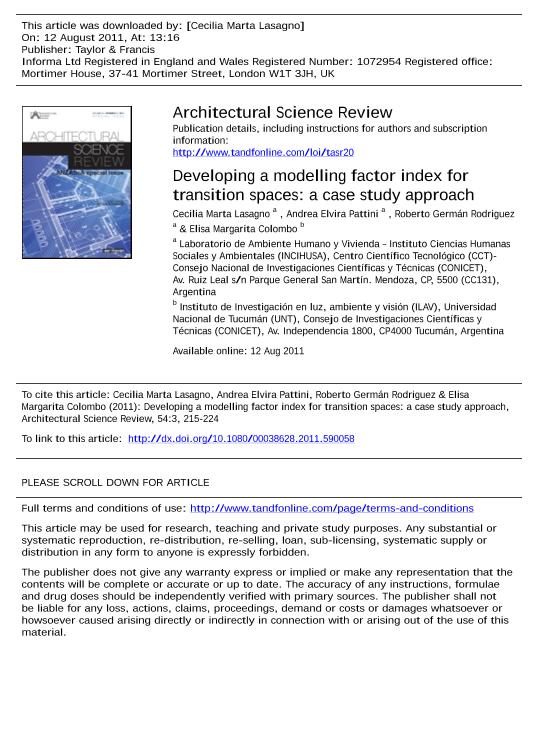Artículo
Developing a modelling factor index for transition spaces: A case study approach
Lasagno, Cecilia Marta ; Pattini, Andrea Elvira
; Pattini, Andrea Elvira ; Rodriguez, Roberto Germán
; Rodriguez, Roberto Germán ; Colombo, Elisa Margarita
; Colombo, Elisa Margarita
 ; Pattini, Andrea Elvira
; Pattini, Andrea Elvira ; Rodriguez, Roberto Germán
; Rodriguez, Roberto Germán ; Colombo, Elisa Margarita
; Colombo, Elisa Margarita
Fecha de publicación:
12/08/2011
Editorial:
Taylor & Francis
Revista:
Architectural Science Review
ISSN:
0003-8628
Idioma:
Inglés
Tipo de recurso:
Artículo publicado
Clasificación temática:
Resumen
Transitional spaces (TS) are characterized by possession of high gradients of luminances between inside and out, which places a great demand on the users' visual system's function. A satisfactory descriptive indicator of this kind of situation could be a 'modelling factor' (MF), defined from cylindrical illuminance and horizontal illuminance measures. It would provide information on the depth and dimensionality of objects present in the scene, also taking into account a region's overabundance of daylight. A public building was selected as a case study, and solar light behaviour, including its interaction with the space, was monitored. Measurements were taken during an entire year at the start of each season (2008) under clear skies, at the beginning and at the end of each working day. Another measurement was taken in winter (2009) under overcast skies at 13:00, so as to obtain a comparative parameter. It was found that unfavourable conditions were produced in all seasons for about 2 hours, except at 09:15 in winter. All the data collected in the control situation were within the optimum modelling range, with values ranging between 0.3 and 0.4. The MF allows the integration of most relevant factors intervening in TS and emerges as a good descriptor for TS.
Palabras clave:
DAYLIGHT IMPACT
,
LIGHT MODELING
,
TRANSITIONAL SPACE
,
VISUAL ADAPTATION
Archivos asociados
Licencia
Identificadores
Colecciones
Articulos(INCIHUSA)
Articulos de INST. DE CS. HUMANAS, SOC. Y AMBIENTALES
Articulos de INST. DE CS. HUMANAS, SOC. Y AMBIENTALES
Citación
Lasagno, Cecilia Marta; Pattini, Andrea Elvira; Rodriguez, Roberto Germán; Colombo, Elisa Margarita; Developing a modelling factor index for transition spaces: A case study approach; Taylor & Francis; Architectural Science Review; 54; 3; 12-8-2011; 215-224
Compartir
Altmétricas



